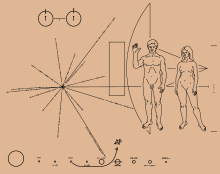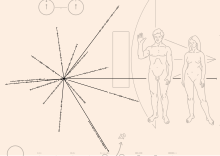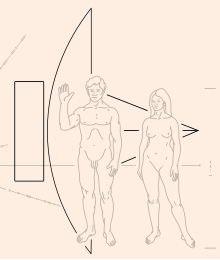Pioneer badge
The Pioneer plaques are two gold plates that are attached to the two interstellar space probes Pioneer 10 and Pioneer 11 . The plaques were made in 1972 as a message to extraterrestrials in the hope that any intelligent, extraterrestrial life forms could learn about mankind and their position in the universe , even if the probability of this is extremely low.
The plates are made of aluminum and are coated with gold . They are 228.6 mm x 152.4 mm and 1.27 mm thick.
The most striking figure on the plaque are a man and a woman . When the schematic drawings were published at the time, a heated discussion broke out in the United States about whether or not the human genitals should be depicted so uncovered. Some scientists also suggested that the man's hand raised in greeting could be mistakenly misunderstood by aliens as an aggressive gesture.
In the background the silhouette of the Pioneer probe can be seen on the same scale . To the left of it, the position of the sun in relation to 14 pulsars and the center of the Milky Way is coded. Below is a representation of our solar system with the eight planets as well as the dwarf planet Pluto (which at that time still had planetary status) and the travel route of the space probe in it. At the top left is the representation of a hyperfine structure transition of the hydrogen atom .
A similar message can be found in the Voyager 1 and Voyager 2 probes launched a few years later in the form of the Voyager Golden Record .
prehistory
That the Pioneer probes should carry a message from humanity was originally suggested by Eric Burgess during a visit to the Jet Propulsion Laboratory during the Mariner-9 mission. He turned to Carl Sagan , who in 1971 had helped organize a conference in Yerevan about possible communication with extraterrestrial life forms and who was enthusiastic about the idea. The NASA agreed with the project and had three weeks to prepare a message. Sagan created the plaque together with Frank Drake , the artistic representations on it were made by Sagan's wife Linda Salzman Sagan .
symbolism
Hyperfine structure transition of the hydrogen atom
At the top left of the badge is a representation of the hyperfine structure transition of a hydrogen atom. Hydrogen is the most common element in the universe. Below the drawing you can see a small vertical line that represents the number 1 in binary. The angular momentum transition of the hydrogen electron from state +1 (spin-up) to state −1 (spin down) describes on the one hand a unit of length (wavelength, 21 cm) and a unit of time (frequency, 1420 MHz ). Both units are used as a scale in the other representations on the badge, so this is universal.
Representation of man and woman
A man and a woman are shown schematically on the right side of the badge, standing in front of the probe as a size comparison. In binary notation, the number 8 (binary: 1-0-0-0) is placed between the two lines that indicate the height of the woman. Measured in the unit of length of the hydrogen transfer (0.21 m), the result is a height of 8 · 0.21 m = 1.68 m.
The right raised hand of the man is said to represent the goodwill of humanity. It can also indicate a hand movement such as a friendly wave; it also shows how the human limbs can be moved. Originally Sagan wanted to depict people holding hands, but he soon realized that an extraterrestrial intelligence could possibly understand that this is one being and not two separate ones.
The representation of the female genitalia is not very clear, only the mons pubis is visible. Sagan and his wife, who had little time to complete the plaque, suspected NASA would have declined to provide a more detailed account, so they compromised to be on the safe side. Another draft with a more precise representation, with a short line indicating a vulva , was rejected by John Naugle, NASA's chief scientist at the time, and deleted.
Carl Sagan himself wrote:
“The decision to omit a very short line in this diagram was made partly because conventional representation in Greek statuary omits it. But there was another reason: Our desire to see the message successfully launched on Pioneer 10. In retrospect, we may have judged NASA's scientific-political hierarchy as more puritanical than it is. In the many discussions that I held with such officials up to the Administrator of the National Aeronautics and Space Administration and the President's Science Adviser, not one Victorian demurrer was ever voiced; and a great deal of helpful encouragement was given. "
“The decision to leave out a very short dash in this diagram was made in part because it is missing from the conventional representation of Greek statues. But there was another reason - our longing to see the message successfully launched with the Pioneer 10. In retrospect, we may judge NASA's scientific-political hierarchy to be more puritanical than it is. In the many conversations I had with such officials, including the administrator of the National Aeronautics and Space Administration and the science advisor to the President, not a single moral objection was raised and full support was given. "
Relative position of the sun
The drawing in the middle left shows the position of the sun in comparison to the center of the galaxy (Milky Way) and 14 pulsars . 15 lines start from the same origin, with 14 lines having an associated binary number. These numbers indicate the duration of the pulsar's rotation (frequency with which it emits radiation). Since the pulsars change their frequency over time (this decreases), one can calculate the start of the probe from the data. The length of the line indicates the relative distance between the sun and the pulsar. A graduation mark at the end of each line indicates the Z- coordinate for the Galactic coordinate system . If the badge is found, not all pulsars may be visible from the location in space. Therefore, as much information as possible was given, even if the information is largely redundant . This enables the determination of our sun by means of triangulation , even if only a few pulsars should be visible.
However, an indication is misleading. At the time of creation, the frequency of the pulsar "1240" (today's name: "J1243-6423") was given as 0.388 seconds, which are only three significant digits and therefore not very accurate. On the badge, the value is given as 100000110110010110001001111000. A value rounded to 10 binary digits (100000110100000000000000000000) would have provided an indication of the uncertainty. The affected pulsar is indicated by the long line that runs down to the right. The long horizontal line that runs through between people indicates the distance between the sun and the center of the Milky Way .
Solar system
At the very bottom of the plaque is a schematic representation of our solar system . The space probe is also shown, a curve ( trajectory ) marks the path of the probe, past Jupiter and finally out of the solar system. Both Pioneer probes (10 and 11) have exactly the same badge. This means that the Pioneer 11 probe's badge is inaccurate, as it also flew past Saturn and not just Jupiter. The entire course shown and the target area therefore deviate greatly from reality.
The rings of Saturn could also have been helpful in identifying the solar system. The rings around the planets Jupiter , Uranus and Neptune were not known at the time the plaque was created. In addition, Pluto was still one of the planets in our solar system. However, in 2006 it was downgraded to a dwarf planet by the International Astronomical Union . The binary numbers for the planets indicate the relative distance to the sun (the distances on the plaque are not to scale because the planets can be better represented). The counting unit here is one tenth of the orbit of Mercury .
Silhouette of the spacecraft
The silhouette of the space probe is drawn in behind the two people as a scale , so that the size of the people and all other sizes can be deduced with its help. These are all also available as information about the hydrogen definition (see above), so the probe as a yardstick is not the only method for determining the units.
criticism
Critics claim the depictions on the plaque are too anthropocentric and very difficult to understand, especially of another way of life. The badge was created with the aim of accommodating as much important information as possible in a very small space, with less attention paid to legibility and comprehensibility. Many researchers who were shown the badge were unable to correctly interpret all of the information.
See also
Web links
Individual evidence
- ↑ Communication with extraterrestrial intelligence , First international conference on extraterrestrial civilizations, 1971 Sept., Soviet Armenia, bibcode : 1972cwei.book ..... p
- ^ Carl Sagan: The cosmic connection; an extraterrestrial perspective . Anchor Press, Garden City 1973, ISBN 0-385-00457-5 , pp. 22-24 .





